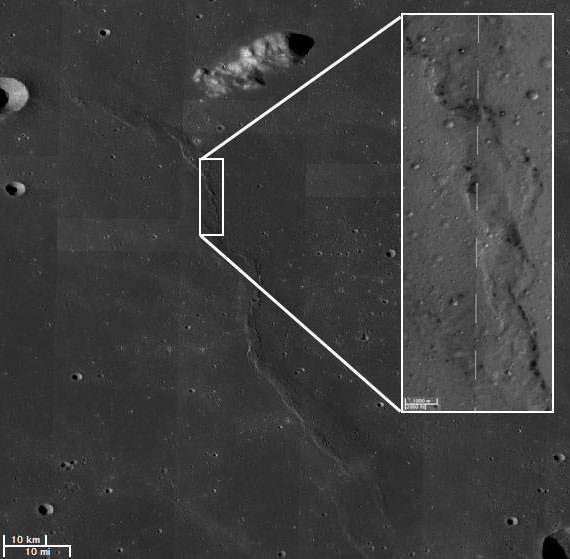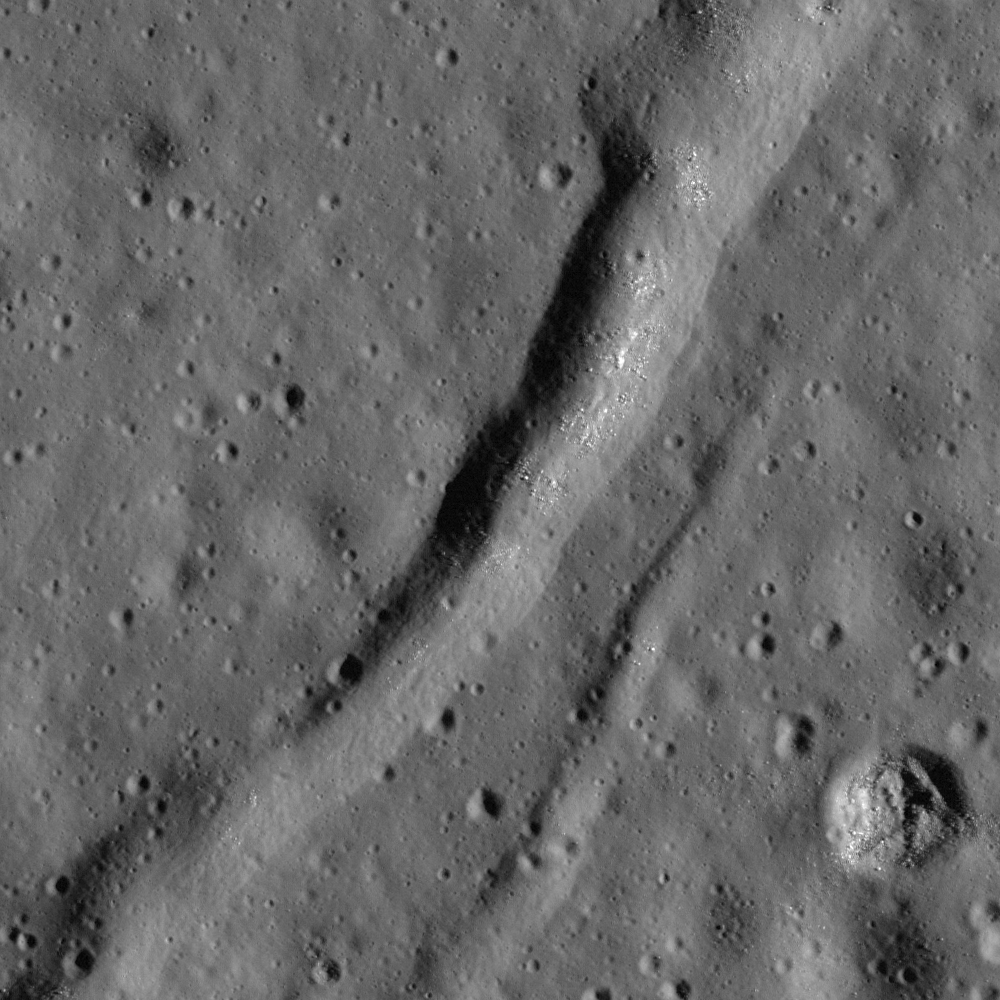[/caption]
Wrinkle ridges have been seen on the surface of the Moon for over a century. Studies of these interesting features began as early as 1885, with telescopic photographs, and continued beyond the Apollo era, with satellite and lander observations. Scientists thought they understood them, but the latest images from the Lunar Reconnaissance Orbital Camera (LROC) suggest we may not know the whole story.
By definition, wrinkle ridges are narrow, steep-sided ridges that form predominantly in volcanic regions. They are very complex features, which can be either straight or curved, or even be braided and zig-zagged. Their width can be anything from less than 1 km to over 20 km. And their heights range from a few meters (say the height of an average room) to 300 meters (about the height of a 100-story sky scraper). They are also asymmetric, with one side of the ridge being higher than the other. Often, these things sit on top of a gentle swell in the landscape. Features like this have been found on a number of planets throughout the Solar System, including the Moon, Mars, Mercury, and Venus.

Image credit: NASA/GSFC/Arizona State University and the author
Click on the image to explore the LROC data from this area in greater detail
The earliest researchers of lunar wrinkle ridges saw them through telescopes. When looking at the terminator (the line between the dark side and the lit side of the Moon), the angle of the Sun causes spectacular shadows to highlight the topography, allowing these otherwise subtle features to be seen. Scientists in the late 19th century believed that these wrinkle ridges, which were found predominantly in the volcanic mare regions, formed when the cooling magma shrank. The chilled crust at the very top of this magma body was now too large, and wrinkles had to form to accommodate the difference. This process was often compared to the wrinkled skin of a shriveled apple, or the skin on our hands as we age.
The dawn of the space age introduced orbiting satellites, which circled the Moon collecting images that were more detailed than had been possible ever before. Data from the 1960’s the Lunar Orbiter (LO) program, whose mission was to photograph the Moon in preparation for the Apollo missions, showed many more of these wrinkle ridge features.
Some researchers felt the LO data pointed to a volcanic origin for wrinkle ridges. They saw lava flows emanating from the wrinkle ridges and embaying impact craters. They suggested that lava flowed to the surface along linear fractures that exploited zones of weakness in the lunar crust (presumably, these weaknesses formed when impacts created the basins that lunar mare occupy). Lava that extruded onto the surface formed the wrinkle ridge features, while magma that intruded below the surface formed the regional swell the ridges sit on.
The Apollo missions, however, were able to provide information about what was happening below the surface, with the Apollo Lunar Sounder Experiment (ALSE). Data collected over a wrinkle ridge in the southeastern portion of Mare Serenitatis showed that there was some kind of topographic structure beneath the thin mare layers in this area. This suggested that wrinkle ridges were the surface expressions of thrust faults in the underlying crust. This interpretation was appealing because it explained why some wrinkle ridges are found outside of mare areas.

Image credit: NASA/GSFC/Arizona State University
Click on the image to learn more about this discovery from NASA's LROC team.
Later, studies of wrinkle-like features on Earth refined our understanding of how these features form. Now the thinking is that wrinkle ridges form by tectonic buckling of the mare areas and their surroundings. When mare lavas are extruded on the surface of the Moon, they fill up the impact basins in a series of basalt layers. The thinned crust left by the basin-forming process can’t support the weight of the mare, so the entire structure sags. The mare layer can become decoupled from the underlying regolith (the “soil” layer that impacts created between the time the basin was formed and when the first mare lavas extruded) and slide towards the sagging centre. As it does so, it bunches up in places where the decoupling is not complete. This creates a series of thrust faults at the base of the mare layer, which show up as wrinkle ridges at the surface. This decoupling process is more pronounced for thinner mare layers, which explains why we often see wrinkle ridges at the edges of a mare.
Recent findings from the Lunar Reconnaissance Orbiter Camera (LROC) may challenge this current understanding of wrinkle ridge formation. LROC images from the mare in Tsiolkovskiy crater have identified wrinkle ridges that are considerably different from the ones seen before. For one, these wrinkle ridges are not asymmetrical in profile, but have a uniformly curved shape. Also, they are much smaller, measuring less than 100 meters in width, as opposed to the 1-20 km widths seen for other wrinkle ridges.
It remains to be seen if these new wrinkle ridges will again change our understanding of how these enigmatic features form. The discovery of these particular ridges is so new that there is nothing yet published about them! Perhaps this image and others like it will help us learn more about these enigmatic features and answer questions such as: does this new wrinkle ridge represent the beginnings of their formation process and that all such ridges started out so small and symmetrical? Or maybe we’ll find that they are extrusions of particularly viscous lava, which have barely protruded above the surface along a linear fault.
Scientists plan to target this area for further data acquisition, because only more data from LRO and further research will help solve the mysteries of the wrinkled Moon.

I wonder why NASA hides images and video from the moon, who regularly receive thanks programa “GRAIL”?
light damages the fibers in the skin called elastin. The breakdown of these fibers causes the skin to lose its ability to snap back after stretching. As a result, wrinkles form. Gravity also is at work, pulling at the skin and causing it to sag, most noticeably on the face, neck, and upper arms. http://www.1wallmart.com/product.php?id_product=589 Cigarette smoking also contributes to wrinkles. People who smoke tend to have more wrinkles than nonsmokers of the same age, complexion, and history of sun exposure. The reason for this difference is not clear. It may be because smoking also plays a role in damaging elastin. Facial wrinkling increases with the amount of cigarettes and number of years a person has smoked.
Many products currently on the market claim to ?revitalize aging skin.? According to the American Academy of Dermatology, over-the-counter ?wrinkle? creams and lotions may soothe dry skin, but they do little or nothing to reverse wrinkles.
Uhhh…….what does this post have to do with wrinkle ridges on the *moon*? The moon does not “smoke” but is exposed to a lot of harsh sunlight.
I suspect this is a spambot post.